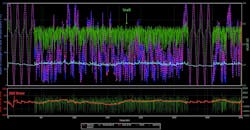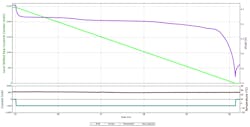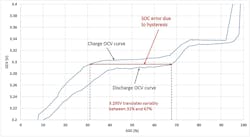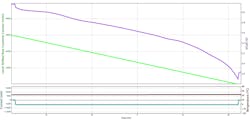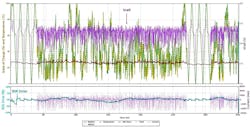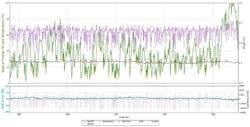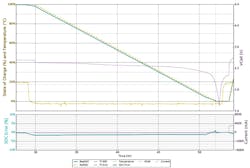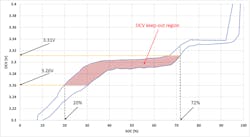Why Special Care is Needed When Fuel-Gauging LiFeP04 Batteries
Lithium-iron-phosphate (also known as lithium ferrous phosphate, LiFeP04, or LFP) batteries are used in certain high C-rate applications. Given their peculiarities, special care needs to be taken while fuel-gauging them. This article covers why these battery types are ideal for certain applications, the special considerations that should be taken into account while fuel-gauging these batteries, and test results using a fuel-gauging algorithm configured for LFP batteries.
Growing Popularity of Lithium-Ion Battery Types
The share of lithium-ion (Li-ion) batteries used around the world keeps growing every year. Known for their high energy densities, low rates of self-discharge, and negligible memory effects, Li-ion batteries are used to provide electrical power in various applications.
Numerous variations of Li-ion batteries are on the market, each with their unique characteristics. Nonetheless, these batteries can be combined into groups based on their chemistries. Each chemistry type has its own advantages and drawbacks, thus allowing it to be used in specific applications. The main groups of Li-ion batteries are outlined in the table.
A Closer Look at LFP Batteries
Advantages
Lithium iron phosphate is used in the cathode of LFP batteries, while carbon is used in the anode. LFP batteries are thermally and chemically more stable than batteries with other chemistries. They don’t combust even during fault conditions such as overcharge or short-circuit, and aren’t prone to thermal runaway. The batteries may also be used in a wide range of temperatures from −40 to 70°C.
At the same time, LFP batteries offer longer cycle life, from 1000 to 2000 cycles, compared to LCO, LMO, NMC, and NCA cells. LFP cells may be exposed to high voltage for a prolonged time with much lower stress than other chemistries. They may be discharged up to a very high 25C-rate.
Drawbacks
LFP batteries have lower nominal voltages of 3.2 V, which means that the specific energy is lower than in LCO, LMO, NMC, and NCA cells. The cells are also sensitive to moisture and water. Direct contact with water leads to a loss of active lithium from the olivine structure and, thus, reduces the material's energy density. Therefore, only high-quality cells, manufactured under strict quality control, can tolerate moderate external moisture conditions. Just like batteries with other chemistries, LFP batteries tend to perform worse at colder temperatures.
Typical Applications
LFP batteries are used in a wide variety of applications. They include small electric vehicles, electric green mowers, scissor lifts, garbage trucks, robotics, home energy storage, hybrid generators, truck APU systems, weather-monitoring devices, ocean buoys, oil and gas pipeline equipment, license-plate monitoring devices, depth finders, paddle boards, and playground equipment.
Why is Fuel-Gauging LFP Batteries Difficult?
1. Shown are a typical discharge curve of an LFP battery (top) and hysteresis in LFP cells along with an associated SOC error of 35% (bottom).
LFP batteries have very flat discharge curves and hysteresis, making it very hard to fuel-gauge these cells. Figure 1 (top) shows a typical discharge curve of an LFP battery. It can be seen that in some regions, voltage barely drops as the battery gets discharged for an extensive amount of time. Figure 1 (bottom) shows the hysteresis of LFP cells and state-of-charge (SOC) error associated with it. In contrast, Figure 2 shows a typical discharge curve of a lithium-nickel-cobalt aluminum-oxide battery, where voltage drops significantly during discharge.
2. A typical discharge curve of a lithium-nickel-cobalt aluminum-oxide battery.
Some other battery chemistries behave similarly to iron phosphate cells, including lithium cobalt phosphate (LiCoPO4), lithium iron sulphate fluoride (LiFeSO4F), and lithium manganese phosphate (LiMnPO4).
How to Accurately Fuel-Gauge LFP Batteries
There are techniques available to derive higher accuracy when fuel-gauging LFP cells. Such cells have extremely flat voltage profiles, where just 1% of change of SOC corresponds to only a few millivolts change on the open-circuit-voltage (OCV) curve. Furthermore, iron-phosphate cells are known for their hysteresis in the OCV curve. A OCV prediction algorithm (without requiring relaxed, full, or empty conditions) combined with a coulomb counter had demonstrated greatly diminished voltage sensitivities when compared with other coulomb-counter methods.
Most alternative methods require observing the battery in the relaxed state and performing corrections based on the measured voltage. In such methods, the corrections are infrequent (a few times per day instead of many small corrections per minute), and the impact of any error during the correction is significant. Any error during the correction is normally frozen in and, therefore, persists until the next correction. Because of this, the choice of algorithm and its use of voltage is especially critical with LFP batteries. An optimal algorithm minimizes these errors by always giving small weight to the voltage corrections; it’s much more resilient to voltage measurement error.
Cell Under Test
We performed a test on an LFP cell using the OCV algorithm with coulomb counting. The battery is ANR26650M1-B with a nominal capacity of 2500 mAh. The chemistry is lithium iron phosphate. Well-tuned fuel gauges have demonstrated the ability to provide excellent fuel-gauging accuracy. We chose a pattern that pushes the fuel gauge to extremes, where the battery is continually used without reaching full or empty for more than a week. Fuel-gauging such a pattern is very challenging even for non-LFP cells. The curves in Figures 3, 4, and 5 below show better than 2% SOC error during the test pattern.
3. The test pattern shows battery voltage, current, temperature, and SOC error. Except for the first cycle, the SOC error always stays under 2%.
4. Accurate fuel gauging is achieved during the complex case of continuous use without reaching full or empty for more than a week. The error stays under 2%.
5. The SOC error stays under 2% even at −5°C.
Example ICs for LFP Battery Fuel-Gauging
In our test case, we used the MAX172xx fuel-gauge IC family. The OCV/SOC curve of LFP is much flatter than conventional lithium-cobalt chemistries, which produces a greater sensitivity to the algorithm's interpretation of cell voltage and OCV.
For the fuel-gauge algorithm to achieve an accurate, full-capacity measurement over time, the battery's full capacity needs to be calculated outside the keep-out window, which has the flattest region and most hysteresis in the OCV/SOC curve. To do this in the MAX172xx, full-capacity learning uses charge sessions and discharge sessions accumulated only when relaxation occurs outside the keep-out window (20% to 72%, for example), when enabled.
Figure 6 shows a OCV-SOC curve of a lithium-iron-phosphate cell as well as an OCV keep-out region.
6. Illustration of SOC-OCV curve for an LFP cell; the OCV keep-out region isn’t used to calculate full capacity to prevent incorrect learning.
To configure the MAX172xx for LFP support, do the following:
- Send the battery to Maxim for characterization. The characterization data should be translated by Maxim into a battery model.
- Set enSC to 1 in the nNVCfg1 (1B9h) register to enable LFP mode and window blocking.
- Load the rest of the battery model (see User Guide 6260 MAX1720x/MAX1721x Software Implementation Guide for more details).
The MAX17055 and MAX1726x support LFP batteries with a special model configuration. To deliver good SOC accuracy, it’s necessary to characterize and model the specific LFP cells being used. These chips provide additional algorithm support specifically for the challenges associated with LFP and other "flat" OCV chemistries.
To configure the MAX1726x and MAX17055 for LFP support, do the following:
- Send the battery to Maxim for characterization. The characterization data should be translated by Maxim into a battery model.
- Write 0x0060 to ModelCFG (DBh) register to enable LFP mode and window blocking
- Load the rest of the battery model (see User Guide 6365 MAX17055 Software Implementation Guide and User Guide 6595 MAX1726x Software Implementation Guide for more details)
Summary
LFP batteries are ideal for certain high C-rate applications, but special care must be taken to achieve accurate fuel-gauging of these battery types. In this article, we discussed a test case using an OCV fuel-gauging algorithm that utilizes coulomb counting. This type of algorithm overcomes some of the accuracy challenges that other fuel-gauging methods encounter with LFP batteries.
About the Author
Georgy Zerkalov
Application Engineer
Jason Wortham
Senior Principal Engineer
Bakul Damle
Business Director of Battery Management, Mobile Group
Business Director of Battery Management for the Mobile Group, Bakul Damle’s current interests include battery and power management specifically in fuel gauges, battery charging, energy harvesting, wireless charging, and battery authentication. He joined Maxim in 2005 and is based in Dallas, Texas.
